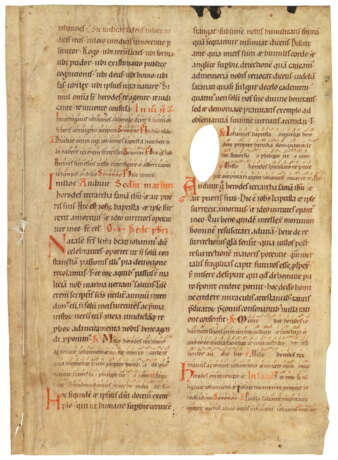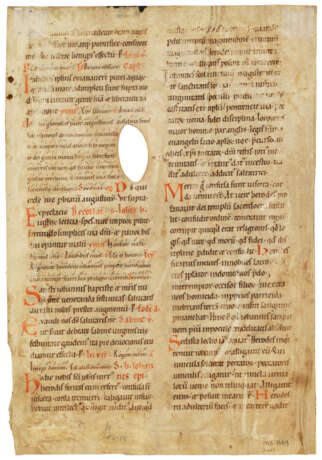ID 1053157
Lot 43 | St Gall neumes (Early German neumes)
Estimate value
£ 2 000 – 3 000
A leaf from a Missal, in Latin, manuscript on vellum [Germany, second half 12th century]
A handsome specimen of Romanesque script and St Gallen neumes.
c.314 x 215mm, 2 columns of 35 lines written in brown ink in a fine Romanesque bookscript, ruled space: c.270 x 180mm, staffless diastematic (heightened) St Gall neumes (Early German neumes), initials and rubrics in red (a natural flaw in the vellum, some marginal staining and darkening, a few creases, but generally in fine condition). Bound in grey buckram at the Quaritch bindery.
Provenance:
(1) Antiquariat J. Voerster, Stuttgart.
(2) Bernard Quaritch, acquired in 1993 by:
(3) Schøyen Collection, MS 1669.
Text:
The fragments contains the text for the Feast of St Augustine, for the Decollation of John the Baptist and for St Sabina, with antiphons, responses, psalms, hymns, and collect, including Bede’s Homily, Book 2, Sermon 20; beginning, on the verso as bound: '[fiduciam sperandae pietatis] indulges intercedente beato Augustino confessore tuo atque pontifice' and ending, on the recto as bound: 'Puelle saltanti imperavit mater nichil aliud petas nisi caput Iohannis evavae'.
Script and music:
The hand is a fine example of that transitional period between Carolingian and Gothic minuscules. The letter-forms are beginning to take on a slight angularity, and they tend to slope somewhat to the right, but they still preserve the clarity and legibility of Carolingian script. The notation is aligned horizontally above the words and is not diastematic. Rhythm is conveyed by the breaks between neumes and by the little strokes or episemas placed over the signs.
| Place of origin: | Germany |
|---|---|
| Auction house category: | Medieval & renaissance manuscripts |
| Place of origin: | Germany |
|---|---|
| Auction house category: | Medieval & renaissance manuscripts |
| Address of auction |
CHRISTIE'S 8 King Street, St. James's SW1Y 6QT London United Kingdom | ||||||
|---|---|---|---|---|---|---|---|
| Preview |
| ||||||
| Phone | +44 (0)20 7839 9060 | ||||||
| Buyer Premium | see on Website | ||||||
| Conditions of purchase | Conditions of purchase |




